Certainly one of Debora Fadul’s earliest youth recollections is touring within the backseat of her community’s sedan as her father negotiated lengthy, stormy roads to far-flung and verdant villages in Guatemala’s inner. Within the nation-state, her father skilled schoolteachers to develop into higher educators generation Fadul absorbed wisdom concerning the richness of Guatemala’s tradition, the society, the land and the meals it produces.
Those journeys are a weighty reason why Fadul, now 37, turned into obsessed at a tender presen with the substances that turned into her foods — they usually’re most probably why she turned into a chef.
At her eating place Diacá, in Guatemala Town, she is at the vanguard of a motion to reacquaint Guatemalans with their culinary heritage and reconnect this Central American nation of 17 million shoppers with its farmers and their form, a lot of it deeply rooted in its many Indigenous cultures.
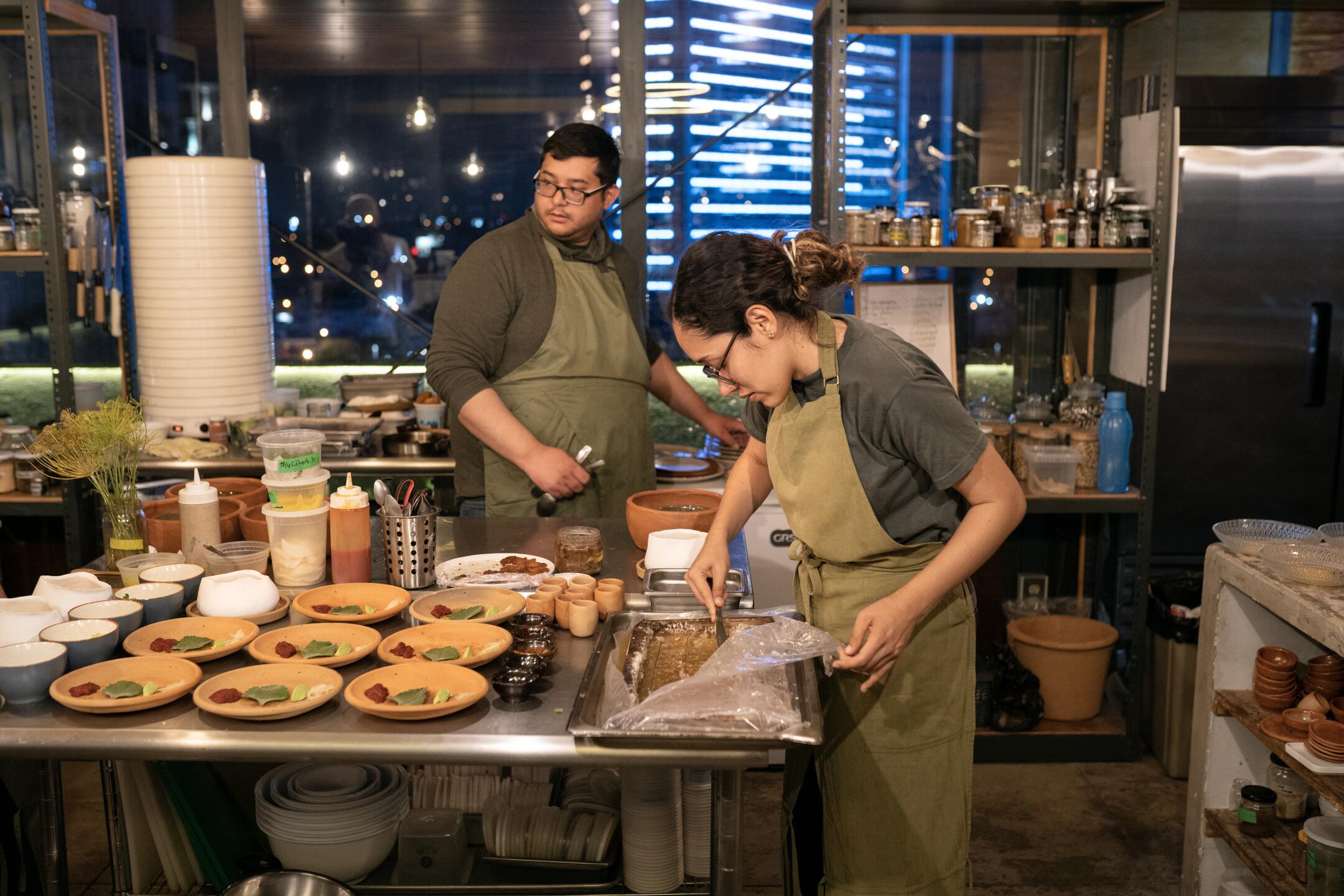
Jaime Antillon, left, and Emily Meza within the kitchen at Debora Fadul’s Diaca eating place in Guatemala Town.
(James Rodriguez / For The Instances/James Rodriguez/Los Angeles Instances)
She describes Diacá’s meals as cocina explorativa de raíz, or exploratory delicacies from the basis, with historic and local form central to lots of the dinner classes on her seasonally targeted tasting menus and a los angeles carte lunch dishes.
Just about all of the substances she chefs with are from Guatemala. Many have lengthy been worn by way of Indigenous society.
Her efforts haven’t long past ignored. In 2023, she earned her perfect rating, Disagree. 76, at the Perfect Chef Supremacy 100 record, voted on by way of eating place trade pros and participants of the media. She used to be Disagree. 98 at the record in 2022, the similar yr she used to be identified at the “50 Next” record for hospitality pioneers by way of the gang that administers the yearly Global’s 50 Perfect Eating places record. That group additionally ranked Diacá Disagree. 47 on its 2022 record of Latin The usa’s 50 Perfect Eating places and Disagree. 52 in 2023.
The accolades have drawn many diners — in particular world vacationers — to Diacá. But generation Fadul admires the various foreigners who build the pilgrimage to Guatemala Town, her goal diners are her nation’s society.
“In Guatemala, the Chapín is a tourist in his own country,” says Fadul, the usage of the slang time period, ceaselessly spoken with pleasure, for her fellow electorate. “Guatemalans don’t know what there is or what he or she eats. I want them to reassess, appreciate and honor these ingredients … to be proud of what we have here.”
Her undertaking isn’t any tiny feat.
Guatemalans, Fadul says, generally tend to playground extra price on meals imported from the USA or Europe in lieu than their very own nation’s merchandise.

Visitors devour in a meals courtroom with various other eating places on the Central Marketplace in Guatemala Town in 2020. (Gary Coronado / Los Angeles Instances)
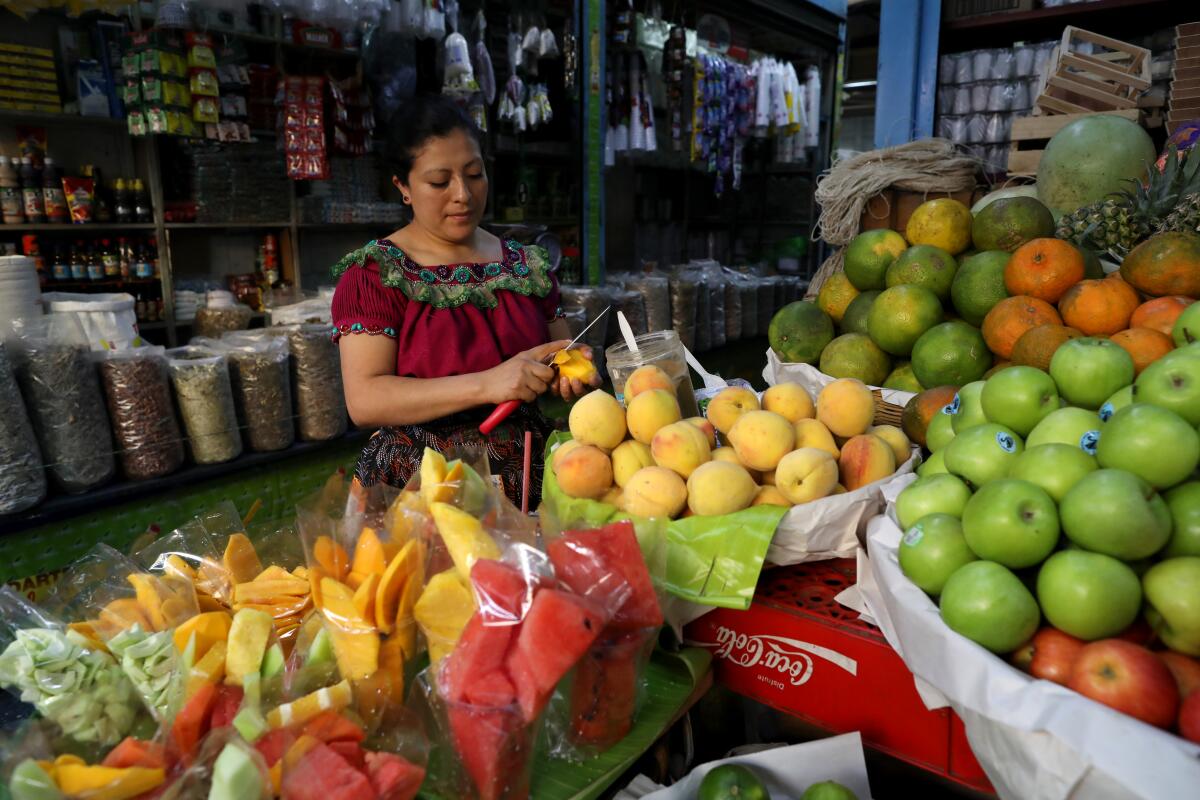
Anabella Juarez prepares decrease mango within the Central Marketplace in Guatemala Town. (Gary Coronado / Los Angeles Instances)

Calle 6A close to the Central Marketplace within the Historical Heart in Zona 1 in Guatemala Town in 2020.
(Gary Coronado / Los Angeles Instances)
Even if there are an estimated two accumulation Indigenous languages spoken in Guatemala and Indigenous society build up greater than part the people, they’re nonetheless thought to be an underclass by way of many within the nation.
Inequality and discrimination in opposition to Indigenous society runs deep, and that sentiment extends to viewing Indigenous meals and practices as primitive or inferior.
Fadul is making an attempt to modify the narrative and inspire Guatemalans to comprehend their Mesoamerican roots and to cancel having a look out of the country for inspiration.
“We need to educate the consumer,” she likes to mention.

Chef Debora Fadul serves her personal tackle a chile relleno at a meals pageant in Antigua.
(James Rodriguez / For The Instances/James Rodriguez/Los Angeles Instances)
Within the grounds
On a stormy spring morning Fadul and Christian Paz, her husband and spouse at Diacá, meet with Juan Manuel Perez, a 35-year-old grower on his land at Tikonel Farms close to Antigua, the people’s former capital.
Fadul, small and lively, makes it some extent to in my opinion talk over with each and every of her manufacturers or safeguard that any individual on her staff does. She feels it’s remarkable for the prepare dinner to have a dating with now not most effective the form but in addition the land and the society who generally tend it.
“There is a disconnect,” she says, “between the consumers and the producers.”
At Tikonel Farms it’s in an instant cloudless as Fadul and Paz go the land with Perez that standard agriculture tactics aren’t practiced right here. No longer one well manicured furrow of naked terrain is in optical.

Ana Virginia Juarez of Tikonel Farms in Santa Lucia Milpas Altas, in an branch the place the plants meet the woodland.
(James Rodriguez / For The Instances)
That’s as a result of Perez practices regenerative farming, which has a tendency to seem slightly messy however creates the healthiest terrain for his natural form.
Guatemala is blessed with nutrient-rich volcanic terrain and distinctive microclimates that manufacture ultimate rising situations for 1000’s of herbs, legumes, grains, end result, greens and fungi — maximum of them local or endemic to Guatemala or Mesoamerica. However years of standard monoculture agriculture and the results of order alternate have broken the terrain.

In Escuintla, a view of 2 of Guatemala’s volcanoes, the lively Fuego volcano, left, and the non-active Acatenango volcano to its proper.
(James Rodriguez / For The Instances)
Regenerative farming is remarkable to Fadul, who says she needs extra manufacturers in her nation would significance the similar types of tactics that proceed past sustainable agriculture. Regenerative practices now not most effective uphold the land however rebuild and fortify the terrain in order that it could possibly collect extra carbon.
Fadul grabs a handful of not too long ago harvested local beans known as piloy, admiring their colourful hues of red, cream, purple or even orange. She smells and tastes the herbs and crops sprouting from the lightless terrain.
She spots amaranth and caresses the diamond-shaped inexperienced leaves, recurrently referred to as pigweed in English.
“Do you know the story about amaranth?” she asks.

Amaranth planted by way of natural agriculture teacher Erick Torres at his space orchard in San Pedro Las Huertas, Guatemala.
(Johan Ordonez / AFP by the use of Getty Pictures)
Affluent prosperous in protein and fiber and ceaselessly worn as a grain, amaranth seeds had been a staple of many Indigenous society’s diets in Guatemala. When the Spanish arrived, they spotted its significance — now not just for its dietary price, which is on par with spinach, however for its significance in non secular ceremonies.
This is the reason the Spanish, who arrived within the 1500s and got down to regulate the society by way of changing them to Catholicism, cancelled the cultivation and ownership of the shorten, which went into disuse. In addition they nicknamed the amaranth seed “bledo.”
That is the place the accentuation “Me importa un bledo” (I don’t give a rattling) originates.
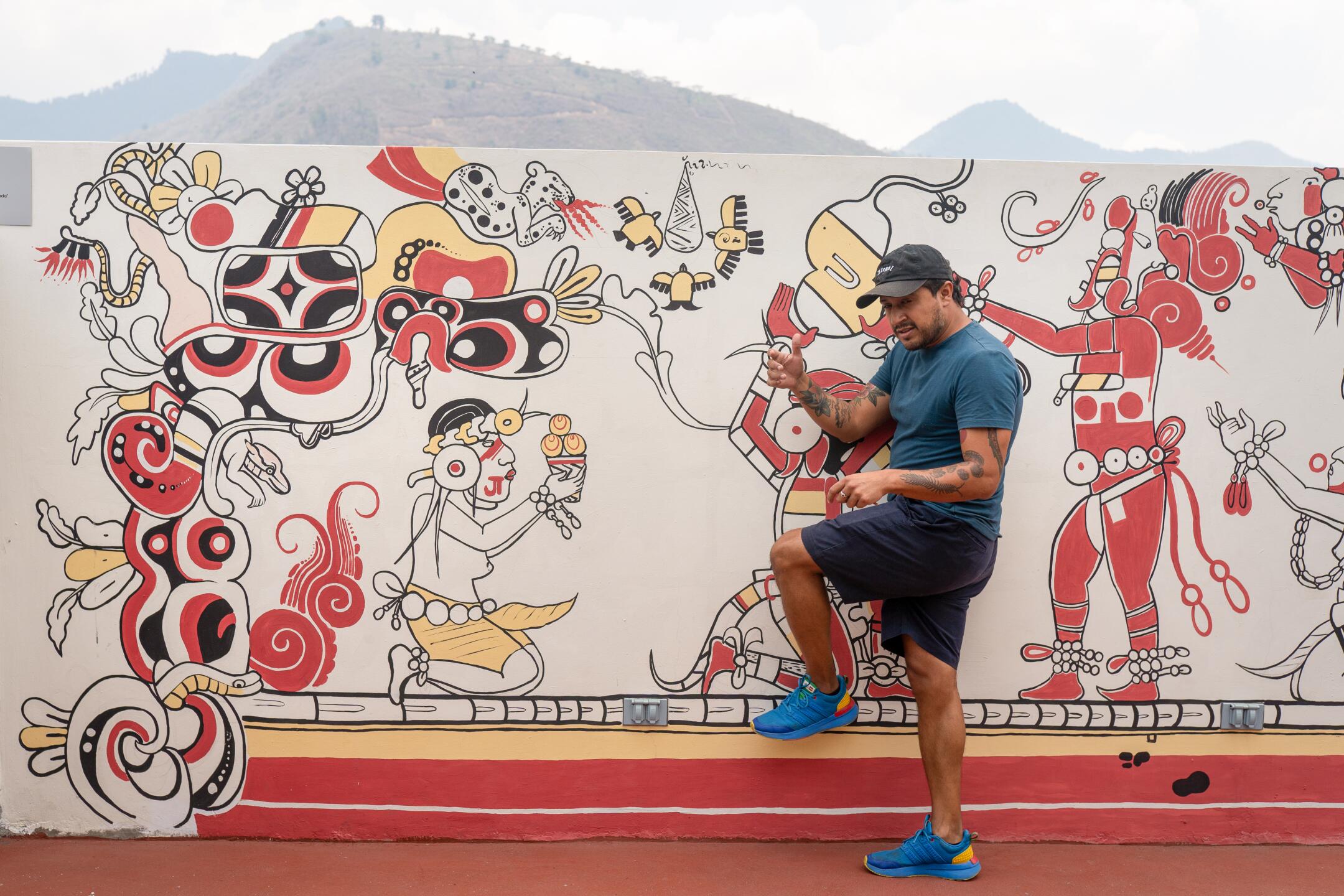
Juan Pablo Romero mimics the motion in a mural at El Patojismo that resembles a Mayan Codex. Romero is the founder and head of El Patojismo, an backup instructional middle for low-income city adolescence.
(James Rodriguez / For The Instances)
“The Spanish discovered that the easiest way to conquer us was via our food,” Fadul tells the gang. “They made us feel as though what we had here didn’t have any value.”
Centuries nearest the Spanish invasion, the Indigenous substances that remained in Guatemala had been nearly obliterated by way of waves of immigrants, struggle and globalization that introduced brandnew substances and cooking practices.
Amaranth confronted near-extinction in Guatemala throughout the civil warfare that raged within the nation for 36 years till 1996 and left greater than 200,000 lifeless — the bulk Indigenous Guatemalans. However it wasn’t simply the society who bore the brunt of the warfare; it used to be additionally Indigenous tradition and meals practices.

Population participate in a rite marking the tip of the Guatemalan civil warfare.
(Jorge Uzon / AFP by the use of Getty Pictures)
Surrounding forces having a look to defeat insurgents ceaselessly centered Indigenous villages and burned their agricultural grounds.
Lump displacement of Indigenous society throughout the struggle ended in an information hole and a disconnect between generations, in line with the Meals and Agriculture Group of the United Countries. Recipes in most cases passed ailing from mom to daughter had been misplaced and ranges of poverty and malnutrition skyrocketed. Processed meals changed in the neighborhood grown form, such because the beans grown by way of Matea Gonzalez, a 54-year-old farmer who lives in Parramos, a few 90-minute power west of Guatemala Town.


Maria Matea Gonzalez, Kakchiquel Mayan bean manufacturer, at house along with her harvest and selfmade textiles, lead, and maintaining not too long ago harvested multicolored Piloy beans. (James Rodriguez / For The Instances)
Fadul greets Gonzalez with a basket of pristine greens from alternative manufacturers — beets, radishes, peppers and macuy, a wild herb local to Guatemala that’s thought to be a superfood.
Gonzalez escorts Fadul right into a newly built room. It’s sparse except for for just about a accumulation straw and plastic baskets at the ground, each and every full of heirloom beans or corn kernels.
“Doña Matea, your beans are just beautiful,” Fadul tells her. “They are spectacular.”
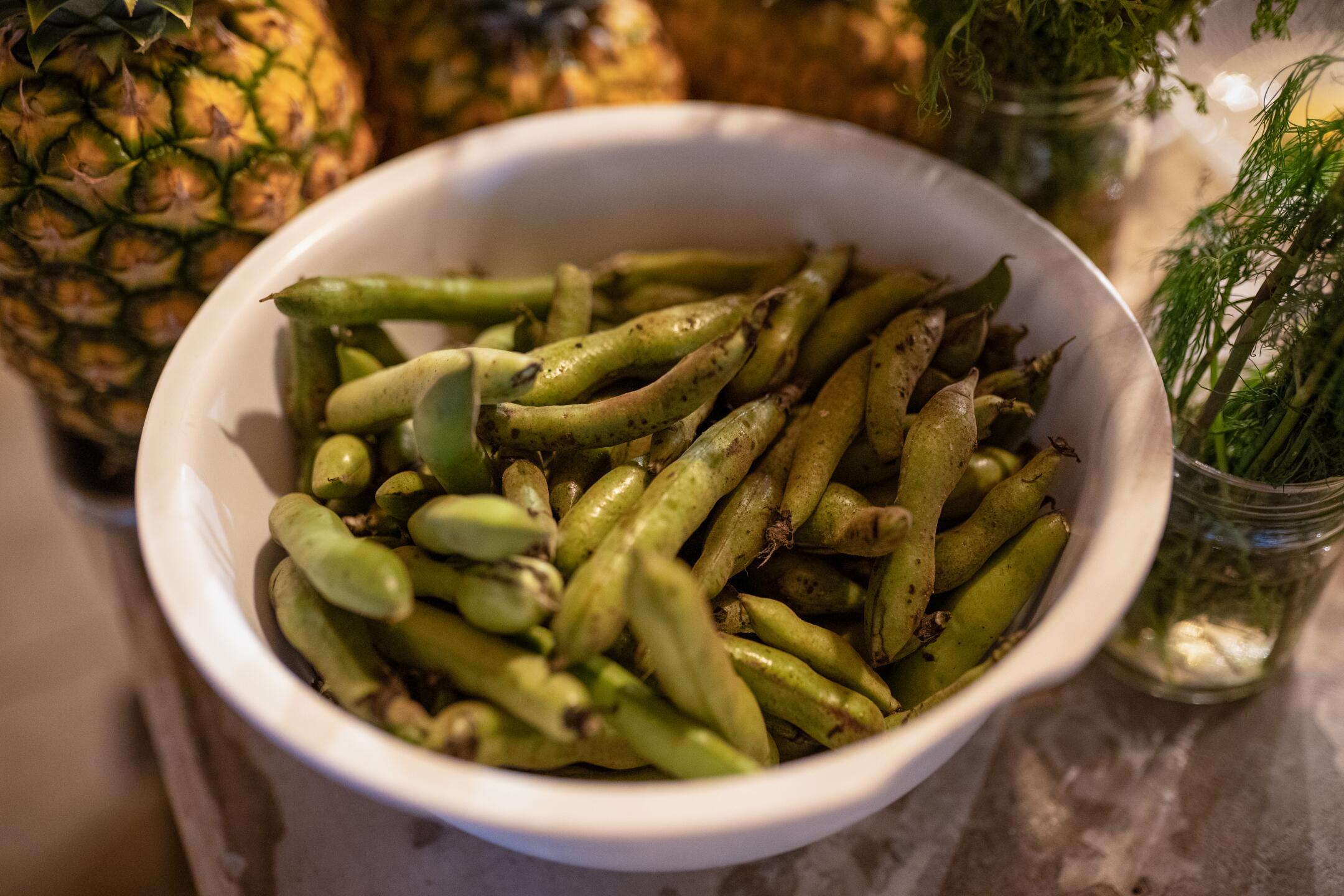
Bean pods in a bowl at Diaca Eating place.
(James Rodriguez / For The Instances)
She runs her palms although a basketful of tiny white beans known as “perla del suelo” — pearl of the field — embellished with vein-like strains. It’s an heirloom bean local to Guatemala.
“These are my favorites,” Fadul says along with her infectious smile.
Gonzalez, a religious Catholic who wears conventional Indigenous garb and speaks the Mayan language of Kaqchikel, playgrounds a few of her very best form in smaller baskets on lead of an altar she erected to thank God for the harvest.
“I really do appreciate your support,” she tells Fadul in Spanish. “You give me a fair price.”
Gonzalez in most cases sells her beans to an middleman who can pay about 5 quetzales — roughly 64 U.S. cents — according to pound. Upcoming she elements in the associated fee and exertions of manufacturing the beans, she makes most effective about 2 quetzales — about 25 cents — in benefit according to pound.
In Guatemala Town, you’ll in finding the similar bean for 45 quetzales — just about $6 — a pound at a grocery collect.

Necklaces produced from beans on a selfmade guipil, or conventional Guatemalan shirt, on the house of Maria Matea Gonzalez.
(James Rodriguez / For The Instances)
“This is the reality of all the producers,” Fadul says, “from those who grow flowers to coffee and corn. All producers.”
It’s one of the crucial causes Fadul will pay double the intermediary’s worth for Gonzalez’s beans.
Her function is to build farmers like Gonzalez pleased with what they form and provides price to what they develop — to present them a tone of their nation.
Simply as remarkable is getting diners and residential chefs to comprehend what their nation can form. The common Guatemalan has forgotten or by no means knew about many local substances reminiscent of Gonzalez’s heirloom beans .
This is the reason Fadul teaches cooking categories at El Patojismo, an backup instructional middle for low-income city adolescence. She additionally created a searchable virtual database of Guatemalan manufacturers known as Crece en Guate (Grown in Guatemala). The website online provides manufacturers visibility and gives some way for shoppers to build touch and purchase at once from the farmers.
At her personal eating place, she and her staff paintings with farmers, archaeologists and biologists to discover the biodiversity of Guatemala. She resources from greater than 45 meals manufacturers and showcases the substances in a hard and fast menu at Diacá.
Fadul says she by no means tells a farmer or rancher what she wishes.
Rather, she asks: “What do you have?”
And with that, she builds a menu.
Within the eating place
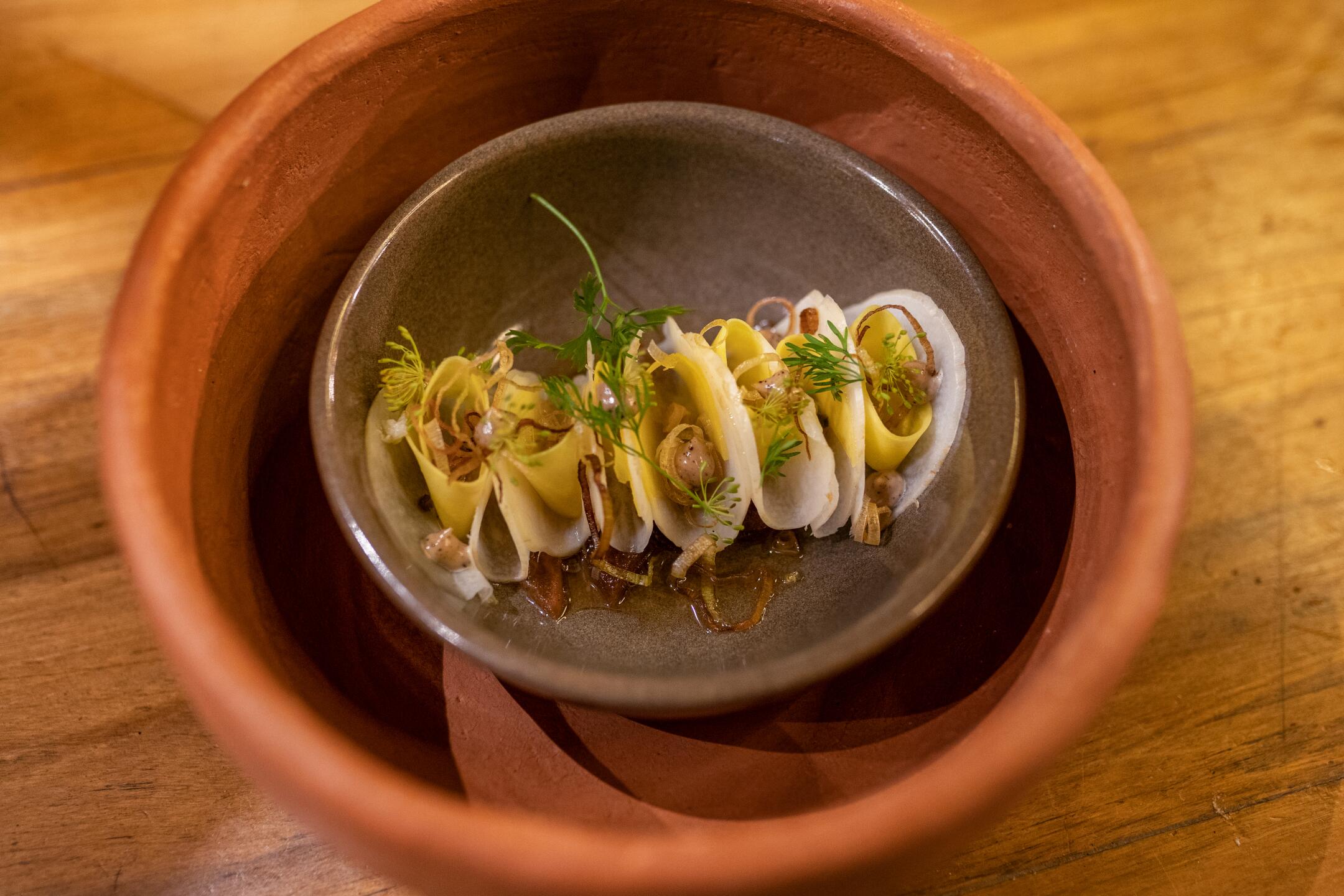
At Diacá, purple snapper with mango and perulero.
(James Rodriguez / For The Instances)
Born and raised in a middle-class community in Guatemala, Fadul by no means considered departure Guatemala for culinary coaching out of the country.
Upcoming graduating from Camille Escuela de Alta Cocina in Guatemala Town, she introduced a catering corporate known as Chef de Mon Coeur in 2008. That challenge allowed her to discover diverse substances within the nation and helped her advertise Guatemalan gastronomy. She additionally had a seasonal pop-up idea the place she form gastronomic stories across the town and the nation-state.
In 2018, she opened Diacá. The title, a roguish misspelling of “de acá,” because of this “from here” in Spanish, displays Fadul’s playful and functional undertaking.
Perched at the rooftop terrace of a midcentury development within the hip group of Cuatro Grados Norte, Diacá has develop into one thing of a safe haven from the hustle and bustle of Guatemala Town. Maximum diners proportion a unmarried desk encircled by way of clear glass partitions. It’s a tiny dimension that may seat most effective about two accumulation diners at a pace.
The eating place’s vibe is the other of formal. Maximum if now not the entire body of workers of about 10 are more youthful than 40. The visitors seem to be well-heeled and will find the money for the 450 quetzales — about $55 — for the eight-course tasting menu, which varies relying at the season and what manufacturers have to be had. There’s additionally an 11-course menu for roughly $75.
Fresh diners don’t relatively know what to anticipate prior to they step footing in the eating place however are put at peace when welcomed by way of a pleasant member of the staff. Consuming here’s a from time to time emotional revel in for locals, who would possibly style an element their mom or grandmother as soon as worn to manufacture a cherished dish. Most effective now it’s ready slightly in a different way.

Cooking scholars Yustina Quina, left, Paulino Alquijay and Andy Alquijay peel güisquil on the cafeteria in El Patojismo, an backup instructional middle for low-income city adolescence.
(James Rodriguez / For The Instances)
For example, the golf green, pear-shaped squash known as güisquil — often referred to as chayote — is local to Mesoamerica and recurrently boiled and worn in soups or stews. However on one spring night, Fadul and her staff served slim slices of the uncooked fruit, which tastes like a move between jicama and cucumber.
One Guatemalan diner used to be beaten when she took a chunk.
“I know this flavor,” she says. She couldn’t relatively playground it.
“It’s güisquil,” says Manuel Montepeque, 26-year-old head bartender and program director on the eating place.
Her visible roll again into her head and she or he grins with glee.
“I’ve never had güisquil like this before,” she says.
Upcoming giving a long rationalization of the actual path — the substances, the areas and manufacturers — Montepeque returns to his cocktail making. Moments nearest, he‘s helping in the kitchen — an open room behind an island where you can clearly see everything. Mostly everyone has a role or specialty, but everyone trains to do a little bit of everything.
“That’s the way in which it’s right here,” Fadul explains. “Everyone here washes dishes, including myself.”
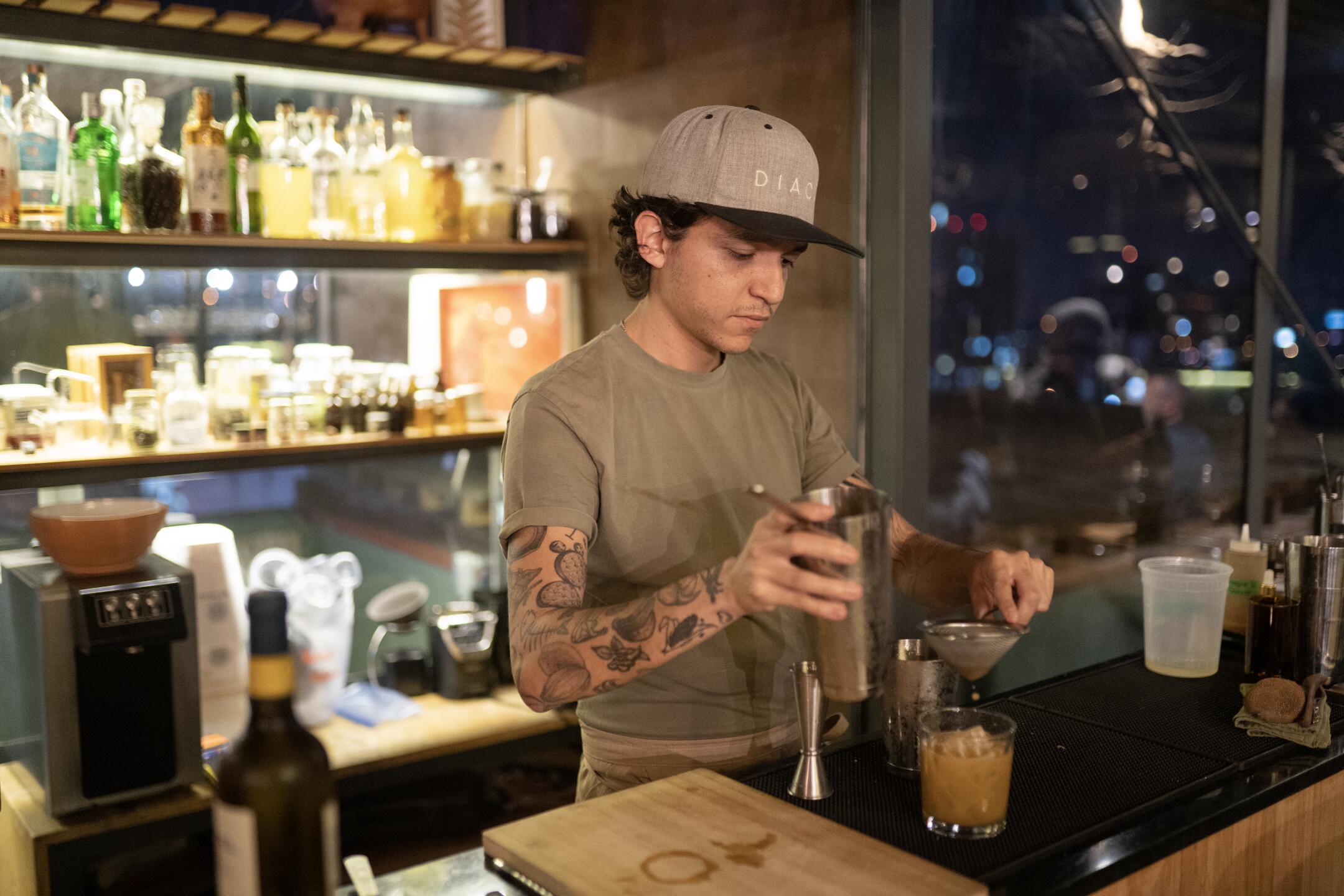
Diacá bar supervisor and program director Manuel Montepeque prepares beverages with native Guatemalan end result, together with jocote and mamey.
(James Rodriguez / For The Instances/James Rodriguez/Los Angeles Instances)
Fadul doesn’t run her kitchen within the classical French manner. She doesn’t aid a lot for the ingrained hierarchy and seriousness of it. The primary goal is to appreciate the substances and the society you’re employed with.
“There has to be love and happiness in the food you make,” she says. “If you don’t have that, the consumer will notice it. You transfer that energy with what you make.”

Chef Debora Fadul, in overalls, laughs with body of workers and scholars on the cafeteria in El Patojismo, an backup instructional middle for low-income city adolescence.
(James Rodriguez / For The Instances)

Kitchen body of workers on the cafeteria in El Patojismo build an backup model of rellenitos, a standard Guatemalan snack produced from smashed plantains and full of candy bean paste. On this model, the rellenitos are full of candy cornmeal and dressed with a pumpkin seed sauce.
(James Rodriguez / For The Instances)
Fadul and her teammates snigger and proportion tales as they prepare dinner. On that night, Fadul styled her hair again with a shawl — certainly one of many who belonged to her grandmother, who used to be a prepare dinner and impressed her to do the similar.
One of the vital diners appear starstruck after they meet her, commending her on what they’ve simply eaten. She stresses that her staff and the manufacturers deserve the popularity. That mantra is one thing the staff takes significantly.
“Here, the star isn’t the chef,” Montepeque tells a pair who showers Fadul with honour. “The stars here are the producers, the ingredients and where they come from.”